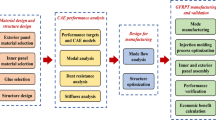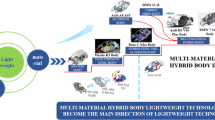Abstract
This paper describes the integrated fabrication and assembly approach used to replace a steel body cover in Samand Sarir automobile by composite one because composite could perform higher mechanical performance, i.e., strength, stiffness, and impact absorption energy at low velocity. Considering the integrated body as base design criteria, the steel cover is redesigned and fabricated by composite material. Tensile, flexural, and charpy impact tests were carried out to determine the properties of woven fabric laminated composite in [0/90°] and [±45°] fiber orientations. The selected composite laminate shows 2.9 times impact resistance; its desirability factors are improved 1.8 times for strength and 3.35 times for stiffness. Using finite element method, the impact of the composite body cover was simulated by ABAQUS for several thicknesses and fiber orientations. The FEM results indicate that finally laminated composite [0/90°]7 can improve the crashworthiness of composite part in comparing to steel body cover. The integrated 3D preform of glass woven fabric was stitched like the shape of 3D model of body cover and placed in mold for prototype fabrication. It can be concluded that vacuum bagging as suggested fabrication method could be suitable for 3,000–5,000 annual production volume. Eventually, the fabricated composite body cover weighed 1.7 kg, which is 42% lighter than the steel body cover.
Similar content being viewed by others
References
Bush JW, Sousanis J, Zajaz P (eds) (2006) Ward's motor vehicle facts and figures. Ward's Automobile Group, Southfield, MI
Stephen EP (2007) Examining fuel economy and carbon standards for light vehicles. In: International Transport forum. USA
Kim H-S, Ben G, Aoki Y (2007) Comparison of experimental results with FEM ones of rectangular CFRP tubes for front side members of automobiles, 6th International Conference on composite materials, July 8–13. Kyoto, Japan
Das S (2001) The cost of automobile polymer composites: a review and assessment of DOE’s lightweight materials composites research. ORNL/TM-2000/283, Oak Ridge National Laboratory, January
Aoki Y, Ben G (2004) Car-body shape and safety-examination for car-body shape and safety design. IATSS Rev 29(4):261–268 (in Japanese)
Kindervater CM, Georgi H (1993) Composite strength and energy absorption as an aspect of structural crash resistance. In: Norman J, Tomaz W (eds) Structural crashworthiness and failure. Elsevier Science, London, pp 189–235
Hufenbach W, Gude M, Ebert CHr (2006) Tailored 3D-textile reinforced composites with load-adapted property profiles for crash and impact application. Composites 6(3):8–13
Boeman RG, Johson NL (2002) Development of a cost competitive, composite intensive, body-in-white. Society of Automobile Engineers, Inc. (Abstract)
Atas C, Sayman O (2008) An overall view on impact response of woven fabric composite plates. Compos Struct 82:336–345
ISO 527-4 (1997) International standard, plastics-determination of tensile properties-part 4: test condition for isotropic and orthotropic fiber-reinforced plastic composites
ISO 178 (1993) International standard, plastics-determination of flexural properties, 3rd Ed
ISO 179-1 (2000) Determination of charpy impact properties-part 1: non-instrumented impact test
Crawford RJ (1998) General properties of plastics, plastics engineering, 3rd Ed, Butterworth-Heinemann, An imprint of Elsevier Science, Linacre House, Jordan Hill, Oxford OX2 8DP
Cramer DR, Targgart DF (2002) Design and fabricate of an affordable advanced-composite automobile body structure, 19th International battery, hybrid and fuel cell electric vehicle symposium & exhibition, EVS-19, http://www.rmi.org/images/other/Trans/T02-10_DsnManuAdvComp.pdf
Clark JP (1998) Future of automobile body materials: steel, aluminum& polymer composites. Massachusetts Institute of Technology, Hoogovens Technology Day October
Weimer C (2003) Perform-engineering: applied sewing technologies to incorporate part and process functions into dry textile reinforcements. Compos Sci Technol 63:2089–2098
Kelly A (1990) Concise encyclopedia of composite materials. MIT press, Cambridge, pp 24–31
Insurance Institute for Highway safety Side Impact, Crashworthiness Evaluation Crash Test Protocol (Version V), May 2008, http://www.iihs.org/ratings/protocols/pdf/test_protocol_side.pdf.
Author information
Authors and Affiliations
Corresponding author
Rights and permissions
About this article
Cite this article
Golzar, M., Poorzeinolabedin, M. Prototype fabrication of a composite automobile body based on integrated structure. Int J Adv Manuf Technol 49, 1037–1045 (2010). https://doi.org/10.1007/s00170-009-2452-6
Received:
Accepted:
Published:
Issue Date:
DOI: https://doi.org/10.1007/s00170-009-2452-6




